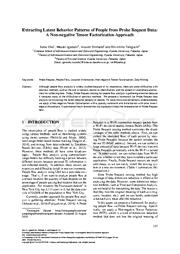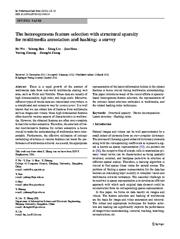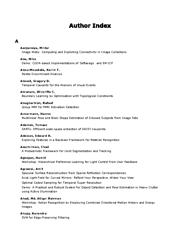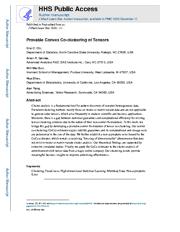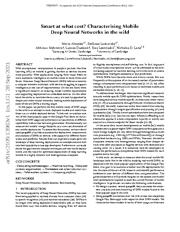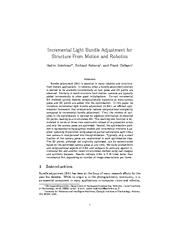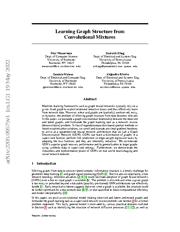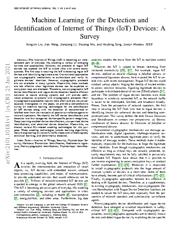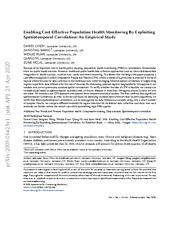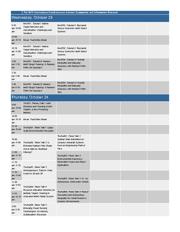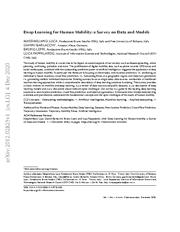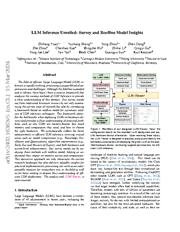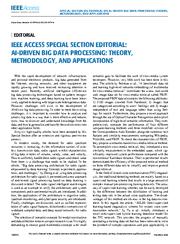A copy of this work was available on the public web and has been preserved in the Wayback Machine. The capture dates from 2019; you can also visit the original URL.
The file type is application/pdf.
Filters
Extracting Latent Behavior Patterns of People from Probe Request Data: A Non-negative Tensor Factorization Approach
2017
Proceedings of the 6th International Conference on Pattern Recognition Applications and Methods
To make the extracted patterns understandable, we apply a Non-negative Tensor Factorization with a sparsity constraint and initialization with prior knowledge to the analysis. ...
Although people flow analysis is widely studied because of its importance, there are some difficulties with previous methods, such as the cost of sensors, person re-identification, and the spread of smartphone ...
., Ltd. for supporting our research. ...
doi:10.5220/0006193901570164
dblp:conf/icpram/OkaIST17
fatcat:s7mas2eevrhjjpge2stri3zl7y
The heterogeneous feature selection with structural sparsity for multimedia annotation and hashing: a survey
2012
International Journal of Multimedia Information Retrieval
Therefore, the selection of limited discriminative features for certain semantics is hence crucial to make the understanding of multimedia more interpretable. ...
There is a rapid growth of the amount of multimedia data from real-world multimedia sharing web sites, such as Flickr and Youtube. ...
The CP decomposition factorizes a tensor into a sum of component rankone tensors. An interesting property of tensor decompositions by CP is the uniqueness under a weak condition. ...
doi:10.1007/s13735-012-0001-9
fatcat:4ihorofn6zbg3mzqnifihgcydm
Author Index
2010
2010 IEEE Computer Society Conference on Computer Vision and Pattern Recognition
by Batch Mode Re-Tagging Tsuji, Akira Silhouette Transformation based on Walking Speed for Gait Identification Tsumura, Norimichi Workshop: Precomputed ROMP for Light Transport Acquisition Tu, Zhuowen ...
Fast Sparse Representation with Prototypes Huang, Junzhou Automatic Image Annotation Using Group Sparsity Huang, Kaiqi Visual Tracking via Incremental Self-tuning Particle Filtering on the Affine Group ...
doi:10.1109/cvpr.2010.5539913
fatcat:y6m5knstrzfyfin6jzusc42p54
Provable Convex Co-clustering of Tensors
2020
Journal of machine learning research
Moreover, there is a gap between statistical guarantees and computational efficiency for existing tensor clustering solutions due to the nature of their non-convex formulations. ...
Cluster analysis is a fundamental tool for pattern discovery of complex heterogeneous data. ...
Acknowledgments The authors thank Xu Han for his help with the simulation experiments during the revision of this work. ...
pmid:33312074
pmcid:PMC7731944
fatcat:bjrmicvonfcupkwzctaprj44tq
Smart at what cost? Characterising Mobile Deep Neural Networks in the wild
[article]
2021
arXiv
pre-print
On the other hand, the strive to maximise the accuracy of a task is supported by deeper and wider neural networks, making mobile deployment of state-of-the-art DNNs a moving target. ...
Simultaneously, we measure the models' energy footprint, as a core cost dimension of any mobile deployment. ...
Heat dissipation of the open design, cross-manufacturer configurations and low-level configuration of the Android Scheduler can all be contributing factors. ...
arXiv:2109.13963v1
fatcat:bwoxnnfsjbh6rgjxcrooijfthi
Incremental light bundle adjustment for structure from motion and robotics
2015
Robotics and Autonomous Systems
The resulting cost function is formulated in terms of three-view constraints instead of re-projection errors and only the camera poses are optimized. ...
First, the number of variables in the optimization is reduced by algebraic elimination of observed 3D points, leading to a structureless BA. ...
Stephen Williams, College of Computing, Georgia Institute of Technology, for insightful discussions. ...
doi:10.1016/j.robot.2015.03.009
fatcat:oghrdkkfqbdyzefuogeocnfozm
Learning Graph Structure from Convolutional Mixtures
[article]
2022
arXiv
pre-print
Furthermore, we demonstrate the robustness and representation power of GDNs on real world neuroimaging and social network datasets. ...
However, when said graphs are (partially) unobserved, noisy, or dynamic, the problem of inferring graph structure from data becomes relevant. ...
identification. ...
arXiv:2205.09575v1
fatcat:6w3fuemrcnesfaean5vvcp4bvq
Machine Learning for the Detection and Identification of Internet of Things (IoT) Devices: A Survey
[article]
2021
arXiv
pre-print
In this paper, we provide a comprehensive survey on machine learning technologies for the identification of IoT devices along with the detection of compromised or falsified ones from the viewpoint of passive ...
Meanwhile, we discuss various ML-related enabling technologies for this purpose. ...
Their features are as follows: • Network pruning: Network pruning algorithms use group sparsity regularizers [158] to remove unimportant connections from a regularly trained network. ...
arXiv:2101.10181v1
fatcat:in5x7tp5fbdernmlzyvv52muke
Privacy in trajectory micro-data publishing : a survey
[article]
2020
arXiv
pre-print
directions for research. ...
We survey the literature on the privacy of trajectory micro-data, i.e., spatiotemporal information about the mobility of individuals, whose collection is becoming increasingly simple and frequent thanks ...
Acknowledgements The authors would like to thank Emilie Sirvent-Hien and Marc-Olivier Killijian for the constructive discussions. ...
arXiv:1903.12211v3
fatcat:kyz7k56e6bcunkzmsdz7xdx5ri
Towards Time-Aware Context-Aware Deep Trust Prediction in Online Social Networks
[article]
2020
arXiv
pre-print
This process faces many challenges, such as the sparsity of user-specified trust relations, the context-awareness of trust and changes in trust values over time. ...
There are several applications for trust in Online Social Networks (OSNs), including social spammer detection, fake news detection, retweet behaviour detection and recommender systems. ...
Instead, tensors are one of the most favoured representations for trust relations as they can store data in several dimensions. ...
arXiv:2003.09543v1
fatcat:4ghgxbpepzaaxl3ed2gies7xr4
Enabling Cost-Effective Population Health Monitoring By Exploiting Spatiotemporal Correlation: An Empirical Study
[article]
2020
arXiv
pre-print
collection in the traditional way, while leveraging inherent spatial correlations of neighboring regions to perform data inference for the rest of the area. ...
To verify whether the idea of CPH is feasible, we conduct an in-depth study based on spatiotemporal morbidity rates of chronic diseases in more than 500 regions around London for over ten years. ...
By reviewing these literature and re-examining the problem in this paper, we believe that the spatiotemporal correlations might partially be explained in the perspectives of these factors. ...
arXiv:2005.01423v1
fatcat:p2e43aaogfcczlr7iryz2hepke
Program
2019
2019 International Conference on Control, Automation and Information Sciences (ICCAIS)
In this paper, We proposed the cross-combination neural network called CCNet for the feature extraction module in person re-identification. ...
In this paper, we employ the Tensor Train decomposition with sparsity constraint for the compression of both convolutional layers and the fully connected layers. ...
In this paper, we develop an intelligent video surveillance and state identification system for elevator cabs, in which the information such as the state of cab door, the behavior of human body, as well ...
doi:10.1109/iccais46528.2019.9074650
fatcat:f3libdixzvez3kaeyb5dubekrq
A Survey on Deep Learning for Human Mobility
[article]
2021
arXiv
pre-print
At the same time, it helps deep learning scientists and practitioners understand the fundamental concepts and the open challenges of the study of human mobility. ...
The proliferation of digital mobility data, such as phone records, GPS traces, and social media posts, combined with the predictive power of artificial intelligence, triggered the application of deep learning ...
A synthetic trajectory may resemble a real one and a malicious adversary may use this information for re-identification. ...
arXiv:2012.02825v2
fatcat:r7navzojwnaojncfsx3sbnfsze
LLM Inference Unveiled: Survey and Roofline Model Insights
[article]
2024
arXiv
pre-print
The analyze tool, LLM-Viewer, is open-sourced. ...
new to the field as well as for those seeking to deepen their understanding of efficient LLM deployment. ...
and dense computation, to implement the GPU Tensor Core's sophisticated support for unstructured sparsity. ...
arXiv:2402.16363v6
fatcat:xxlbrecjqnfsbn4uko3xkyvtfe
IEEE Access Special Section Editorial: AI-Driven Big Data Processing: Theory, Methodology, and Applications
2020
IEEE Access
The sparsity of data is one of the main factors restricting the performance of recommender systems. ...
In the article ''Coupled tensor decomposition for user clustering in mobile Internet traffic interaction pattern,'' by Yu et al., the authors focus on the interaction pattern between mobile users and servers ...
Therefore, the calculation of each data point's local outlier factor only needs to be performed inside the small cluster. ...
doi:10.1109/access.2020.3035461
fatcat:rt7ejtponrfexigie4cfpt7gd4
« Previous
Showing results 1 — 15 out of 288 results

